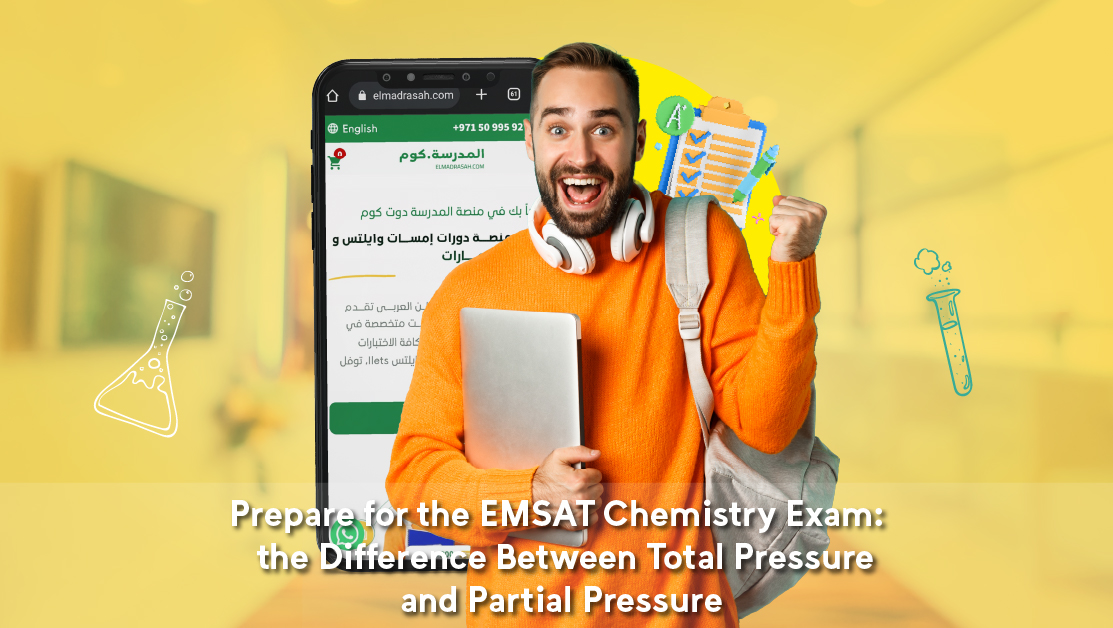
Exams in chemistry are considered an important part of the journey of study and academic achievement, and among the important exams are those for the UAE standard test, the EMSAT exam in chemistry, which is one of the forms of evaluating students’ chemical knowledge and skills, for Preparing for the EMSAT Chemistry, it is necessary to understand and know the difference between many concepts and terms. Among them are total pressure, partial pressure, and the difference between them, and this is what we will know together with the help of elmadrasah.com platform team.
The EMSAT chemistry exam
The EMSAT Chemistry exam is a comprehensive exam that covers a variety of content in the field of chemistry. It requires students to demonstrate their full knowledge and understanding of basic chemical principles and concepts. In addition, the exam covers the concepts and applications of total pressure and partial pressure, and the difference between them, as this is important in the study of physical chemistry.
By mastering these basic concepts and differences in stress, the student will be prepared to face the EMSAT exam in chemistry with confidence and success, and this is what is included in the chemistry review course offered by elmadrasah.com platform, with a distinguished group of distinguished and experienced chemistry teachers, and it includes the following:
The concept of total pressure in chemistry
Total pressure is one of the fundamental concepts in the field of physical chemistry, as it refers to the force that a gas exerts on a unit surface area of the container it occupies. The total pressure is affected by several factors, including the amount and type of gas in the container, the temperature, and the size of the container itself. Total pressure is measured in usual pressure units such as pascals or atmosphere.
Methods of measuring total pressure
There are several methods available to measure total pressure, the most popular of which is the use of barometers. The mercury barometer is one of the famous types of barometers, as it determines the total pressure value by measuring the height of the mercury column. A partial barometer can also be used to measure the partial pressure of different types of gasses inside a container.
By understanding the concept of total pressure and methods of measuring it, students can prepare well for The EMSAT Exam in Chemistry and understand the basic differences between total pressure and partial pressure. Elmadrasah.com teachers also advise students to practice total pressure measurement, understand chemical reactions that depend on total and partial pressure, and Preparing for the EMSAT Chemistry well.
The concept of partial pressure in chemistry
In physical chemistry, partial pressure refers to the pressure exerted by a gas in a gaseous mixture on its surroundings, such as in a laboratory flask, a diver’s air cylinder, or even within the confines of the atmosphere. You can calculate the partial pressure of each gas in the mixture if you know the amount of that gas, the volume it occupies, and its temperature. Partial pressure is denoted by the symbol P.
Calculating partial pressure in gaseous mixtures
You can calculate the partial pressure of each gas in a gaseous mixture using Dalton’s Law of Partial Pressures. According to this law, the partial pressure of each gas depends on its volumetric proportion in the mixture and the pressure of the total mixture of gasses. You can use the following law to calculate the partial pressure of gas A as follows:
P(A) = (n(A) / n(total)) * P(total)
where:
(PA) is the partial pressure of gas A
nA is the amount of gas A in the mixture ntotal is the total amount of gasses in the mixture Ptotal is the total pressure of the gaseous mixture.
Using this law, you can calculate the partial pressure of each type of gas in the mixture and thus understand their effect on the gaseous mixture in the container. Prepare well to take The EMSAT Exam in Chemistry by practicing calculating partial pressure and understanding the chemical reactions that depend on partial pressure and total pressure.
The relationship between total pressure and partial pressure
When a reaction occurs between gasses, there is a change in the total pressure and partial pressure of each gas in the mixture. When the pressure of one gas increases as a result of an arganic reaction, the partial pressure of the other gasses in the mixture decreases. This is due to the law of diaphragmatic stimulation of gasses. Thus, we can use the change in partial pressure to determine how far a reaction is progressing in glasses.
Applications of partial pressure in chemistry
- Using partial pressure to calculate the concentration of ions in gaseous solutions
Partial pressure plays an important role in calculating the concentration of ions in gaseous solutions. When you dissolve a gas in a solution, the partial pressure of the gas is an important factor in determining the concentration of ions in the solution. When we have information about the partial pressure of a gas and the volume of the solution, we can use the ideal gas relationship to calculate the concentration of ions in the solution.
- The effect of partial pressure on the distribution of chemical reactions in a gaseous mixture
Partial pressure can affect the distribution of chemical reactions in a gaseous mixture. When the partial pressure of one gas in a mixture increases, the reactivity of that gas increases and it tends to move toward the other gas. This happens due to the effect of the law of diaphragmatic interaction of gasses. Therefore, partial pressure can be used to find out how it affects the distribution of chemical reactions in a gaseous mixture.
By understanding the difference between total pressure and partial pressure in gasses and using them to calculate the concentration of ions in gaseous solutions and understanding the effect of partial pressure on the distribution of chemical reactions in a gaseous mixture, you are Preparing for the EMSAT Chemistry.
Applications of the use of total pressure in chemistry
Dalton’s law of partial pressures is considered one of the fundamental laws in chemistry and physics. This law specifies that the total pressure of a gas mixture is considered the sum of the partial pressures. This law can be used to calculate several information about the gasses present in the mixture, and by calculating the total pressure, the following can be known:
Calculate the equilibrium constant for partial pressures:
When a chemical reaction is in equilibrium, the total pressure and percent ionization can be used to calculate the equilibrium constant for the partial pressures. This constant can be used to determine the reaction equilibrium and understand the effect of changes in partial pressures on the reaction equilibrium.
Determine the composition of molecules in the mixture:
Dalton’s Law can be used to calculate the partial pressure of each gas in a mixture to determine the composition of the different molecules present in the mixture. For example, it can be used to calculate the partial pressure of oxygen and nitrogen in the air to understand the composition of gaseous components in the air.
Identify catalytic reactions:
Catalytic reactions are chemical reactions that occur in the presence of a substance that contributes to increasing the speed of the reaction. Dalton’s Law can be used to calculate total pressure to determine the reaction occurring in the presence of a catalyst and estimate its effect on the reaction.
Calculate the partial pressure of non-equilibrium gasses:
The total pressure can be used to calculate the partial pressure of non-equilibrium gasses in a mixture. For example, Dalton’s law can be used to calculate the partial pressure of argon in a gaseous mixture and determine the molar concentration of argon in the mixture.
Determine the partial volume of gasses:
Dalton’s law can be used to calculate the molecular volume of gasses in a mixture by using the well-known relationship P = (n/V)RT. This volume can be used to estimate the actual volume of gasses in the mixture and determine the effect on the properties of the mixture.
By applying this law, it is possible to understand and study the behavior of gasses and their properties in many different conditions and applications. Elmadrasah.com teachers may be advised to practice these concepts and explore more practical applications of partial and total pressure in the field of physical chemistry, Preparing for the EMSAT Chemistry, and practice different sample questions in this section of The EMSAT Exam in Chemistry.















